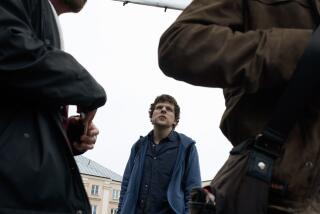Meet the estranged-in-law
What does it mean to belong, and to what extent can we will ourselves to do so? How much does where we come from determine who we are? These are the big questions first-time feature director Phil Morrison poses in “Junebug,” a deceptively simple, deeply resonant story about the inherent loneliness of family, the odds against assimilation and the enormous distances that can divide two people, even when they are standing close enough for one to flick a wrench and hit the other in the eye.
Madeleine (Embeth Davidtz) is a Britishaccented Chicago art dealer who spies the handsome George (Alessandro Nivola) across a crowded auction and marries him a week later. How this happened, what the wedding was like and who moved where are questions that remain unanswered by Angus MacLachlan’s beautifully spare script, as it quickly becomes apparent that this is not a love story, exactly, but a paean to yearning, alienation and endless hope. “Where did you come from?” Madeleine asks on their first night together, a line we immediately recognize as a less hackneyed variant of the well-worn “Where have you been all my life?” George, as elusive as he is charming, replies in the most literal, which is to say cryptic, way. “Pfafftown, North Carolina.”
Six months later -- about two minutes into the movie -- the couple are heading down to George’s hometown, to woo a rural folk artist named David Wark (Frank Hoyt Taylor) and, as long as they’re in the neighborhood, visit George’s family. Madeleine doesn’t know it yet, but she’s about to embark on her own personal “Meet the Parents.” There are no lie detectors awaiting her in the basement, but the visit will hold quiet horrors of its own.
Three years have passed since George’s last visit home, and his father, Eugene (Scott Wilson), mother, Peg (Celia Weston), brother Johnny (Ben McKenzie) and sister-in-law Ashley (Amy Adams) await the couple with a mixture of excitement, anxiety and dread. Peg’s suspicions about the coming intruder are confirmed the minute she sets eyes on the exotically thin, foreign-sounding Madeleine, who disastrously takes to calling her “Pat.” (A mistake George doesn’t bother to correct.) Johnny, meanwhile, is too furious at the world in general and his brother in particular to feel anything but hostility toward the woman he senses will be just another laurel leaf in George’s already fulsome wreath. And Eugene, a quiet, bird-like man who can spend days on a quest to retrieve a misplaced screwdriver, is too much of a visitor in his own home to open it up to anybody.
The minute they walk through the door, something happens to George. He retreats into loner mode and starts self-righteously reclaiming his roots -- singing in church, talking up the value of family -- while at the same time avoiding his parents and leaving Madeleine to fend for herself. So it befalls the irrepressibly bubbly, logorrheic Ashley to make Madeleine feel welcome. She is only too happy to do it. Ashley’s response to Madeleine’s otherness is to fetishize it with the zeal of a small town girl awaiting the return of a local celebrity. She immediately takes Madeleine under her wing, relinquishing all judgment (as Madeleine has of the bigoted Faulknerian idiot Wark) and instinctively protecting her from the unwelcoming Peg and Johnny.
Ashley, of course, has problems of her own. Nine months pregnant and living with her in-laws while her quietly furious husband studies for his GED, she cheerfully puts up with Johnny’s rejection. She has no family other than Johnny’s, but she also intuitively senses that she has something the impressive Madeleine lacks -- a place where she truly belongs. It’s not just that Ashley is Peg’s daughter in a way Madeleine will never be, it’s that she is site-specific down to the color of her nail polish, “cinnamon fizz,” a hue she applies to Madeleine’s lacquer-less nails one afternoon. Peg disrupts the sisterly bonding by sending Ashley on an errand, leaving the stranded Madeleine flapping her hands awkwardly in the center of the room, looking like a giant flamingo in a pond full of ducks.
The more Madeleine tries to ingratiate herself with her new mother- and brother-in-law, the more Madeleine’s artistic specialty seems a poignantly ironic one. Born in Japan to parents in the British foreign service, she spent her childhood moving around the world. It’s hard to imagine a person more “outsider” than she is. Meanwhile, the artist she is courting makes paintings that blend Southern history with his own fantastical dreams. Rural, insular and autistic, he’s as rooted in place and cut off from the rest of the world as it’s possible to be.
There are too many things to like about “Junebug” to enumerate here, but one of the more remarkable is the way Morrison and MacLachlan avoid taking sides with Madeleine or George’s family. Rather than pit the family’s parochial red-state insularity against Madeleine’s relativistic blue-state cosmopolitanism, the filmmakers allow them to co-exist in uneasy harmony. Madeleine’s clumsy attempts to engage Peg in conversation -- when she asks if Peg has ever heard of Wark, Peg repeats the plummy vowel as it sounds to her: “Woah-ock?”-- are no less squirm-inducing than watching her watch George sing a hymn at church. He performs beautifully, but the moment reveals just how much she doesn’t know about him.
Davidtz walks a fine line between being the sympathetic stranger in a strange land and the snooty sophisticate with amazing skill and grace. And Adams’ performance in a role that could have easily devolved into caricature is complex and nuanced. Ashley’s faith and roots provide her with a rudder that Madeleine, for all her worldliness, lacks, and you get the sense that for all of Madeleine’s self-sufficiency and independence, she would drown in Ashley’s place.
George, meanwhile, drifts through the movie like a vapor. At first it seems he’s missing in action, that the movie is not about him at all. But this is Nivola’s exquisitely light touch. George, it dawns later, is the real foreign element: The guy who is never really present where he is and often present where he shouldn’t be. The wrench-tossing happens after George has thoughtlessly usurped Johnny’s place at a sensitive time while all but abandoning Madeleine as her work reaches a crisis. Madeleine may have been a diplomatic corps brat with no place to call home, but George is a true ex-patriot, in self-imposed exile from a home that still feels his absence. And he has the cockiness of someone who’s confident you can go home again and then blow out of town the minute it gets too feel too much like alien territory, which is to say too much like home.
*
‘Junebug’
MPAA rating: R for sexual content and language
Times guidelines: Film contains some nudity and sex scenes
A Sony Pictures Classics Release. Director Phil Morrison. Screenplay by Angus MacLachlan. Produced by Mindy Goldberg, Mike S. Ryan. Executive producers Mark P. Clein, Ethan D. Leder, Daniel Rappaport, Dany Wolf. Cinematographer Peter Donahue. Editor Joe Klotz. Original Music by Yo La Tengo. Costume designer Danielle Kays. Running time: 102 minutes. In limited release.
More to Read
Only good movies
Get the Indie Focus newsletter, Mark Olsen's weekly guide to the world of cinema.
You may occasionally receive promotional content from the Los Angeles Times.










